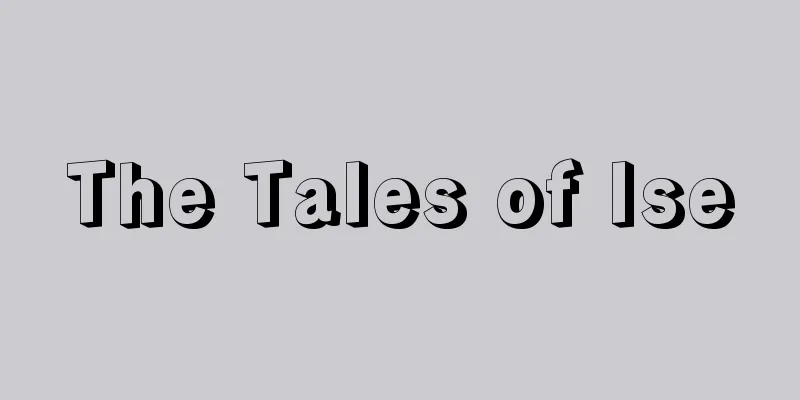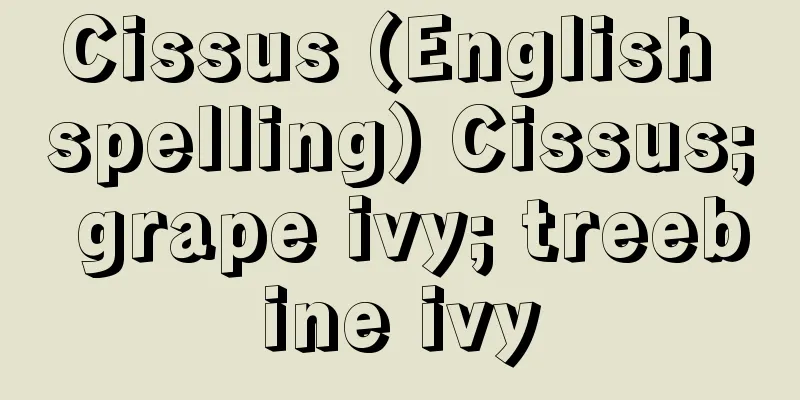The Tales of Ise

|
A song story from the early Heian period. Also known as "Zaigo no Monogatari" and "Zaigo no Chujo no Nikki" ("Zaigo" refers to Narihira, the fifth son of the Ariwara clan). [Hideo Suzuki] ContentsEach story begins with "Once upon a time..." and is a collection of short stories told primarily through waka poetry about the love, friendship, wanderings, and separations of the impressionable "Old Man." The number of chapters is 125 in the popular edition (Teika edition), but this number varies slightly depending on the edition. This "Old Man" is likened to Ariwara no Narihira, and the stories are structured like a biography of his life, from his "First Crown" (coming-of-age ceremony) to his "Father's poem," in which he realizes he is about to die. However, the stories are not arranged in strict chronological order, nor are the chapters closely related to each other. Because the waka poems they compose are Narihira's actual writings, some of the chapters that can be considered to be true stories about Narihira include his forbidden love with Empress Nijō Takako in sections such as "The Western Entrance" and "Akutagawa," his forbidden love with Saigū in sections such as "The Hunting Messenger," his friendship with the fallen Prince Koretaka that goes beyond a relationship of master and servant in sections such as "Nagisa no In," the lonely and sad story of a man wandering the eastern provinces in sections such as "Departure from the East," and the story of Narihira lamenting the death of his aged mother in the section "Aranu Wakare." However, recent research has led to a clear distinction between reality and fiction, as it has been determined that the real Narihira never wandered to the eastern provinces, had no romantic relationships with Empress Nijō or Saigū, and that his friendship with Prince Koretaka was nothing more than a marriage relation. Therefore, while this story is centered on Narihira's waka poems, it has a fictional breadth that far exceeds Narihira's real image. For example, it also contains chapters about local and common people, such as the "Tsutsuizutsu" chapter, which tells of the love of a boy and girl in the countryside and how it ends, and the "Azusayumi" chapter, which tells of the irony of fate in which a woman who remarries after her husband runs away meets her ex-husband. This story contains 209 waka poems (according to the popular edition), of which 35 are thought to be Narihira's. As for the rest, poems other than those by Narihira, such as those from "Manyoshu", "Kokinshu", "Gosenshu", "Shuishū", and "Kokin Rokujō", are made to appear as the work of "Mukashi-otoko". However, since some of the poems are actually written by Narihira, it gives the impression that "Mukashi-otoko" is Narihira himself. Also, since the term "Mukashi-otoko" is an unspecified person, it is a unique method that can be related to Narihira on the one hand, but can also be detached from his real image on the other hand. In relation to this, each story is related on the one hand, but can also be independent on the other hand. Furthermore, the poems in the work do not simply add emotion, but are placed at the center of the story and carry the theme, and the act of the characters composing poems in the work is imbued with great meaning. Often, the act of composing a poem itself is even proof of the existence of that person. Therefore, in order to maximize the lyricism of the waka poem, the prose (poem) is written in a concise style that accurately describes the progression of time, people, and events, and is different from the fixed style of writing in the general collection of poems that explains the circumstances of the poem. Here, a centripetal style is formed that transitions toward the central waka poem. [Hideo Suzuki] EstablishedThe original Narihira-shu was presumably created after Narihira's death (880), and it is believed that the Kokinshu and the original Ise Monogatari were based on it. The original Ise Monogatari is presumably composed almost entirely of Narihira's poems, and even the extant copy from around the end of the 10th century was a small-scale story of less than 50 paragraphs. It was significantly expanded after the 11th century, leading to its current form. The author has long been thought to have been someone from the Ariwara or Ki clan, and one theory is that it was Ki no Tsurayuki due to similarities in writing style. It is completely unknown who expanded it. [Hideo Suzuki] EnjoymentFrom the end of the Heian period onwards, it was read and studied by poets, and Fujiwara no Teika, in the early Kamakura period, copied and revised it many times. In the Muromachi period, renga poets also got involved, and annotations were actively produced. Hosokawa Yusai's "Ise Monogatari Ketsugisho" is a representative work. During the Edo period, when classical Japanese literature was becoming more and more popular, it was highly valued along with "The Tale of Genji," and the publication of woodblock editions increased rapidly, with numerous annotations being produced. Examples include Kitamura Kigin's "Ise Monogatari Shusuisho," Keichu's "Sego Okudan," Kada Azumaro's "Ise Monogatari Dojimon," Kamo Mabuchi's "Ise Monogatari Koi," and Fujii Takanao's "Ise Monogatari Shinyaku." Up until the Middle Ages, poets and renga poets accepted "Mukashi Otoko" as a true account of Narihira's life, but from the early modern commentaries by Harumitsu and Mabuchi onwards, it came to be seen as a fictional story not limited to the deeds of Narihira. [Hideo Suzuki] TranslationIt is classified into five types: (1) 125-section version (the popular version; a copy of the manuscript by Fujiwara no Teika or similar versions, although Teika's handwritten version has not been handed down to this day). (2) Hirohon (fewer chapters than (1)). (3) Abbreviated version (also called Nurigome version; the version with the fewest chapters). (4) Manahon (a special version written only in kanji). (5) Besshon (a version that does not belong to (1)-(4)). [Hideo Suzuki] "Complete Collection of Japanese Classical Literature, Volume 9: The Tales of Ise, edited by Otsu Yuichi and Tsukishima Yutaka (1957, Iwanami Shoten)" ▽ " Complete Collection of Japanese Classical Literature, Volume 8: The Tales of Ise, edited and translated by Fukui Sadasuke (1972, Shogakukan)" ▽ "Shincho Collection of Japanese Classics: The Tales of Ise, edited by Watanabe Minoru (1976, Shinchosha)" ▽ "Study of the Tales of Ise, Edited Edition, Research Edition, and Appendix: Collected Versions of the Tales of Ise, by Ikeda Kikan (1933; Edited Edition and Research Edition republished in 1958, Yuseido)" ▽ "Study of the Tales of Ise, Research Edition, and Reference Edition, by Katagiri Yoichi (1968, 1969, Meiji Shoin)" Old type version (Saga version) Vol. 1 Published in 1608 (Keicho 13) Owned by the National Diet Library The Tales of Ise Volume 1, by Hosokawa Yusai, published in 1634 (Kan'ei 11), held at the National Diet Library "The Tales of Ise: Kekigisho" Source: Shogakukan Encyclopedia Nipponica About Encyclopedia Nipponica Information | Legend |
|
平安前期の歌物語。別称に『在五(ざいご)が物語』『在五中将の日記』(「在五」は在原(ありわら)氏の五男業平(なりひら)のこと)。 [鈴木日出男] 内容それぞれの冒頭が「昔、男……」と始まり、その多感な「昔男」の恋愛、友情、流離、別離など多岐にわたる内容が、和歌を中心に語られる小編の物語集。その章段は、流布本(定家本(ていかぼん))で125段だが、伝本によって多少増減がある。この「昔男」は在原業平に擬せられてもいて、その「初冠(ういこうぶり)」(元服)の段から、死を自覚した「辞世」の段に至る一代記的な構成をとっている。しかし配列上、厳密な年代順でもなければ、各章段相互の関連も緊密でない。詠まれている和歌が業平の実作という点から、とくに業平の実話ともみられる章段に、「西の対(たい)」「芥河(あくたがわ)」などの段の二条后高子(にじょうのきさきたかいこ)との許されぬ恋、「狩の使」などの段の斎宮(さいくう)との禁断の恋、また「渚(なぎさ)の院」などの段の落魄(らくはく)の惟喬(これたか)親王との主従関係を超えた親交、「東下(あずまくだ)り」などの段の東国への漂泊に生きる者のわびしく孤独な話、あるいは「さらぬ別れ」の段の老母との死別を悲嘆する話などがある。しかし近時の研究では、実際の業平は東国に漂泊したこともなければ、二条后や斎宮との恋愛関係もなく、惟喬親王との親交も姻戚(いんせき)関係以上ではなかったとして、その実像と虚像が峻別(しゅんべつ)されるようになった。したがって、この物語は、業平実作の和歌を主軸にしながらも、業平の実像をはるかに超える虚構の広がりをもっている。たとえば、田舎(いなか)の少年少女の恋とその結末を語る「筒井筒(つついづつ)」の段の話、夫の出奔後に再婚した女が元の夫に巡り会う運命の皮肉を語る「梓弓(あずさゆみ)」の段の話など、地方的、庶民的な章段も含まれている。この物語には和歌が209首(流布本による)含まれているが、そのうち、業平実作とみられるのは35首。ほかは『万葉集』『古今集』『後撰(ごせん)集』『拾遺(しゅうい)集』『古今六帖(ろくじょう)』などの、業平以外の和歌を「昔男」の作に仕立てていることになる。しかし部分的に業平実作の和歌が含まれるところから、「昔男」が業平その人であるという印象を与える。また、この「昔男」という呼称が不特定の人称であるところから、一面では業平に即しながらも一面ではその実像から離れることもできるという独自な方法たりえている。それと関連して、一段一段の話も一面では関連しあいながら、一面では独立性をもちえてもいる。また作中の和歌は、単に情緒を添える程度ではなく、物語の中心に据えられて主題性を担い、作中人物たちが和歌を詠むという行為に重大な意味が込められている。しばしば、和歌を詠み上げるという行為自体が、その人物の存在の証(あかし)とさえなっている。したがって散文(詞章)も、和歌の叙情性を極限的に高めるべく、時と人と事柄の推移を的確に語り進める簡潔な表現となっていて、歌集一般の詞書(ことばがき)が詠歌の経緯を説明する固定的な文体であるのとは異なっている。ここでは、中心をなす和歌へ向かって推移する求心的な文体を形成している。 [鈴木日出男] 成立業平の死没(880)後、原『業平集』の成立が推定され、『古今集』や原『伊勢物語』はそれを資料としたとみられる。その原『伊勢物語』はほぼ業平の歌だけからなると推定され、10世紀末ごろの伝本でも50段たらずの小規模な物語であったらしい。11世紀以後に大幅な増補が行われて現在の形態に至る。作者については古来、在原、紀家系の人物が想定され、一説には文体上の類似などから紀貫之(きのつらゆき)ともされる。増補者についてはまったく不明である。 [鈴木日出男] 享受平安時代末からとくに歌人に愛読研究され、鎌倉時代初頭の藤原定家はこれの書写や校訂を幾度も行っている。室町時代になると、連歌師(れんがし)もこれに加わり、注釈も盛んに行われた。細川幽斎(ゆうさい)『伊勢物語闕疑抄(けつぎしょう)』がその代表的著作。江戸時代の古典普及期には、『源氏物語』とともにこれが尊重され、板本の出版が急増して、注釈類もおびただしくなった。北村季吟(きぎん)『伊勢物語拾穂抄(しゅうすいしょう)』、契沖(けいちゅう)『勢語臆断(せごおくだん)』、荷田春満(かだあずままろ)『伊勢物語童子問(どうじもん)』、賀茂真淵(かもまぶち)『伊勢物語古意』、藤井高尚(たかなお)『伊勢物語新釈』などである。中世までの歌人、連歌師たちの享受では「昔男」がそのまま業平の実録として受け止められたが、近世の春満、真淵の注釈あたりからは業平の事跡に限らぬ虚構の物語とみられるようになったのである。 [鈴木日出男] 伝本次のような5種に分類される。(1)百二十五段本(流布本。藤原定家の書写系統やその類似本。ただし定家直筆の本は今日伝わらない)。(2)広本((1)よりも章段数が少ない)。(3)略本(塗籠(ぬりごめ)本とも。章段数がもっとも少ない)。(4)真名(まな)本(漢字だけで表記された特殊な伝本)。(5)別本((1)~(4)に属さないもの)。 [鈴木日出男] 『大津有一・築島裕校注『日本古典文学大系 9 伊勢物語』(1957・岩波書店)』▽『福井貞助校注・訳『日本古典文学全集 8 伊勢物語』(1972・小学館)』▽『渡辺実校注『新潮日本古典集成 伊勢物語』(1976・新潮社)』▽『池田亀鑑著『伊勢物語に就きての研究 校本篇・研究篇・付録「伊勢物語版本聚影」』(1933/校本篇・研究篇 再刊・1958・有精堂)』▽『片桐洋一著『伊勢物語の研究 研究篇・資料篇』(1968、1969・明治書院)』 古活字版(嵯峨本) 上 1608年(慶長13)刊国立国会図書館所蔵"> 『伊勢物語』 巻1 細川幽斎著 1634年(寛永11)刊国立国会図書館所蔵"> 『伊勢物語闕疑抄』 出典 小学館 日本大百科全書(ニッポニカ)日本大百科全書(ニッポニカ)について 情報 | 凡例 |
Recommend
Student corps - Gakutotai
…As defeat became more likely, education disappea...
Connection - Stingy
〘Noun〙① Buddhist term. To form a connection to the...
Idoteidae
…General term for crustaceans of the Isopod famil...
Amada River
…The main river has a length of 146 km and a tota...
Urich - Urichigo
...They also once traveled to southern Sakhalin, ...
Sixteenth Night Diary - Izayoi Nikki
Written by Abutsuni, this is a travel diary of th...
Marcel Deprez
1843‐1918 French engineer. He established the foun...
Unwinding rate - Unwinding rate
...Cocoon inspection involves the visual selectio...
Auerbach, E.
… Based on this reflection, a fierce anti-French ...
Ust-Kan Caves
… [Middle Paleolithic Period] In East Asia, the M...
Bontoc people - Bontoc
A Proto-Malay ethnic group living mainly in Mounta...
Cygnus (the Swan)
Its abbreviation is Cyg. It is a major constellati...
Trust - torasuto (English spelling) trust
It refers to a large monopoly company or a consol...
Dickens Fellowship
...However, because it is extremely difficult to ...
Antlers - Edazuno
Branched antlers found in mammals of the deer fami...









